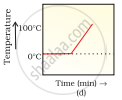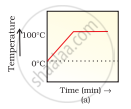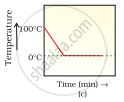Advertisements
Advertisements
प्रश्न
A student heats a beaker containing ice and water. He measures the temperature of the content of the beaker as a function of time. Which of the following (Fig. 1.1) would correctly represent the result? Justify your choice.
विकल्प
उत्तर

Since ice and water are in equilibrium, the temperature would be zero. When we heat the mixture, ‘energy supplied is utilised in melting the ice and the temperature does not change till the ice melts because of latent heat of fusion. On further heating the temperature of the water would increase. Therefore (d) is the correct option.
APPEARS IN
संबंधित प्रश्न
Some ice is taken in a beaker and its temperature is recorded after each one minute. The observations are listed below
| Time (in minute) | Temperature (in °C) |
| 0 | 0 |
| 1 | 0 |
| 2 | 0 |
| 3 | 0 |
| 4 | 0 |
| 5 | 0 |
| 6 | 3.8 |
| 7 | 7.6 |
| 8 | 11.4 |
From the above observations, what conclusion do you draw about the melting point of ice?
State the melting point of ice.
Analogy:
Melting: ice into water on heating,
freezing: _______.
A glass tumbler containing hot water is kept in the freezer compartment of a refrigerator (temperature < 0°C). If you could measure the temperature of the content of the tumbler, which of the following graphs (Fig.1.2) would correctly represent the change in its temperature as a function of time.
Conversion of solid state to liquid state is called fusion; what is meant by latent heat of fusion?
It is a hot summer day, Priyanshi and Ali are wearing cotton and nylon clothes respectively. Who do you think would be more comfortable and why?
Sweating causes cooling because water has a ______.
Ice does not melt rapidly because of ______.
A change of state is a change of a substance from ______.
Define the following:
Melting or fusion:



